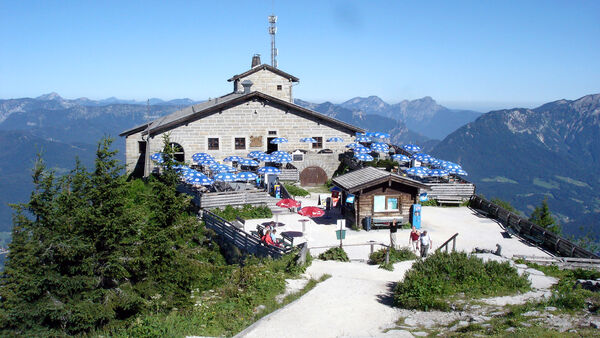The Bavarian Background of Hitler’s Eagle’s Nest
There's much more to Obersalzberg, a scenic mountainside spot above the town of Berchtesgaden, than Hitler's famous lodge.
By Rick Steves
In the 1930s, after becoming the German chancellor, Adolf Hitler was looking for the perfect spot to establish an official mountain retreat — a Camp David for his Nazi regime. He chose Obersalzberg, a dramatically scenic mountainside area a few miles uphill from the market town of Berchtesgaden.
The region, a finger of Bavarian territory that pokes south into Austria, had long been one of the classic Romantic corners of Germany. Hitler had famously credited its landscape — so steeped in legend and close to the soul of the German people — for inspiring him as he finished his manifesto, Mein Kampf, in a rented Obersalzberg cabin in the 1920s. His propagandists capitalized on his love of this region to establish the notion that the native Austrian was truly German at heart.
For his new official retreat Hitler had a once-modest chalet renovated into a supersized alpine farmhouse, named the "Berghof" — the ideal setting for crafting his public image. By 1936 German media was awash in photos of the Führer in Obersalzberg: surrounded by nature, gently receiving alpine flowers from adoring children, lounging with farmers in lederhosen…no modern arms industry, no big-time industrialists, no ugly extermination camps. Party leaders soon took over the rest of Obersalzberg as their own vacation spot.
But Obersalzberg was also home to a huge compound of 80 buildings — fenced off from the public after 1936, and connected by extensive bunkers — where the major decisions leading up to World War II were hatched. Hitler himself spent about a third of his time as chancellor at the Berghof, hosted world leaders in the compound, and later had it prepared for his last stand.
In April 1945, Britain's Royal Air Force bombed the Obersalzberg compound nearly flat, including the Berghof. Seven years later, the Bavarian government blew up most of what had survived the bombing, wanting to leave nothing to attract neo-Nazi pilgrims.
But large sections of the Nazis' bunker system — intended as the regime's last resort as the Allies closed in — still remain. And the bombers had entirely missed the difficult-to-target Kehlsteinhaus, a small chalet on a 6,000-foot outcrop that juts up two miles south of Obersalzberg. (A visiting diplomat humorously dubbed it the "Eagle's Nest," and among English speakers, the name stuck.)
While for many modern visitors "Berchtesgaden" is synonymous with "Hitler's Eagle's Nest," "the Eagle's Nest" actually refers just to this small lodge itself, perched alone amid spectacular scenery like a Bond villain's lair. Built in 1939 with precision stonework evoking fascist obedience, it was Hitler's 50th birthday gift from his inner circle. The lodge and the road up to it cost a fortune — but Hitler, who was afraid of heights, visited only 14 times. (It wasn't even much of a lodge: While Nazi officials met and hosted visiting diplomats here — and Eva Braun was fond of sunbathing on the terrace — it never had any beds.)
Today, the chalet that Hitler ignored is basically a three-room, reasonably priced restaurant with little in the way of artifacts, and views that are often obscured by fog. On nice days, however, the terrace offers a magnificent panorama, and the tunnel, elevator, and mountain road — Germany's highest — that lead to the Eagle's Nest are dramatic in any weather.
For many, however, Obersalzberg's vast bunker system is the more fascinating part of a visit. This professionally engineered underground town held meeting rooms, offices, government archives, and lavish living quarters for Hitler — all connected by four miles of tunnels cut, by slave labor, through solid rock. You can't visit all of it, and what you can see was stripped and looted bare by Allied soldiers. But enough is left that you can wander among the concrete and marvel at megalomania gone mad.
In 1999, a museum — the Obersalzberg Documentation Center — was built atop one of the bunkers. It does a fine job of explaining the history of the site and offers a concise and powerful overview of Nazi history. (As it's designed primarily for the edification of German citizens, there's very little in English here, but an audioguide app makes the visit worthwhile for English speakers.)
Most visit the area as a side trip from Salzburg, which is connected to Berchtesgaden by an easy 50-minute bus ride. (The train ride is longer and much less scenic.) From Berchtesgaden's bus hub you can hop a different bus to the Obersalzberg sites.
As the region's historic Nazi ties have (understandably) overshadowed its once-famed scenery, many visitors miss their chance to experience what made this corner of the Bavarian Alps legendary long before Hitler.
In sunny weather, that's perhaps best done on a sedate boat ride across the fjord-like Königssee, which cuts deep into alpine peaks. Hikers can fold in a walk with their lake visit, or, with less time, hike the secluded Almbach Gorge to a high waterfall. And in the Berchtesgaden salt mines, where cloudy weather isn't a problem, you can ride a little train deep into a mountain to get a first-hand look at local mining history. Thanks to a well-designed bus system, efficient day trippers can easily fit in at least one of these three with an Obersalzberg visit.

